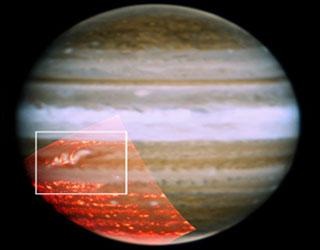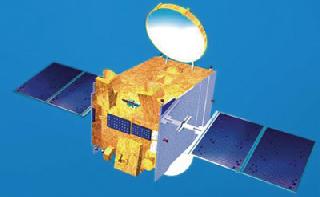
A false-color composite image of Jupiter and its South Equatorial Belt shows an unusually bright spot, or outbreak, in this image made from data obtained by the W.M. Keck telescope in Hawaii on Nov. Photo: NASA
PASADENA (BNS): One of Jupiter's stripes that "disappeared" last spring is now regaining its colour in the new images of the planet.
According to NASA, earlier this year, amateur astronomers noticed that a longstanding dark-brown stripe, known as the South Equatorial Belt in the south region of Jupiter's equator had turned white. Later a dark spot was discovered in the area that was once the dark stripe.
After follow-up observations in Hawaii with NASA's Infrared Telescope Facility, the WM Keck Observatory and the Gemini Observatory telescope, scientists now believe the vanished dark stripe is making a comeback.
"The reason Jupiter seemed to 'lose' this band – camouflaging itself among the surrounding white bands – is that the usual downwelling winds that are dry and keep the region clear of clouds died down," Glenn Orton, a research scientist at JPL, said.
"One of the things we were looking for in the infrared was evidence that the darker material emerging to the west of the bright spot was actually the start of clearing in the cloud deck, and that is precisely what we saw," he added.
This white cloud deck is made up of white ammonia ice. When the white clouds float at a higher altitude, they obscure the missing brown material, which floats at a lower altitude. Every few decades or so, the South Equatorial Belt turns completely white for perhaps one to three years, an event that has puzzled scientists for decades. This extreme change in appearance has only been seen with the South Equatorial Belt, making it unique to Jupiter and the entire solar system.
Scientists have also spotted changes in the Jupiter's Great Red Spot. Orton said the color of the spot – a giant storm on Jupiter that is three times the size of Earth and a century or more old – will likely brighten a bit again as the South Equatorial Belt makes its comeback.
Scientists are particularly interested in observing this latest event because it's the first time they've been able to use modern instruments to determine the details of the chemical and dynamical changes of this phenomenon.
Observing this event carefully may help to refine the scientific questions to be posed by NASA's Juno spacecraft, due to arrive at Jupiter in 2016, and a larger, proposed mission to orbit Jupiter and explore its satellite Europa after 2020.
 Previous Article
Previous Article Next Article
Next Article













The Indian Air Force, in its flight trials evaluation report submitted before the Defence Ministry l..
view articleAn insight into the Medium Multi-Role Combat Aircraft competition...
view articleSky enthusiasts can now spot the International Space Station (ISS) commanded by Indian-American astr..
view article